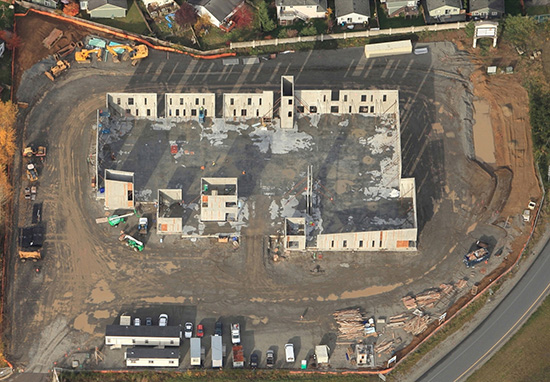|
Subscribe / Renew |
|
|
Contact Us |
|
| ► Subscribe to our Free Weekly Newsletter | |
| home | Welcome, sign in or click here to subscribe. | login |
Construction
| |
 |
May 17, 2013
GRAND AWARD/Tilt-up structures
Everett Clinic Smokey Point Medical Center
Location: Marysville
Owner/developer: The Everett Clinic
Project team: J.R. Abbott Construction, general contractor; ZGF Architects, architect; Coughlin Porter Lundeen, structural engineer; Steckler Construction, concrete contractor; Concrete Nor’west, ready-mix supplier
Early on in the process for the Everett Clinic Smokey Point Medical Center the owner suggested a goal for the design-build team to strive for: affordable elegance.
Concrete tilt-up may not be the first thing that comes to mind for that concept, since it’s usually associated with warehouses and big-box stores. But for this project, tilt-up fit the bill.
The main reason for using tilt-up was to cut costs. The method saved an estimated $160,000 in construction and materials costs. Part of the reason is that the tilt panels were used for multiple facets of the project, such as exterior skin, interior feature walls and structural shear elements.
The finish of the panels was highly scrutinized since the clinic would have more than 20,000 square feet of exposed concrete surfaces. The project team constructed both small-scale and full-scale mock-ups for the tilt panels and their finish. A sand-blast finish was selected after sampling a number of others, including dry-ice blast, soda blast and power sanding.
Because the natural finish of the concrete was left exposed, the clinic will gain the life-cycle benefits of having a lasting, durable finish for the majority of its exterior envelope. With only a sealer required, the initial costs for painting were eliminated, and the long-term maintenance cost will be reduced.
A few additional features were incorporated into the tilt panels to help them integrate with the project’s design. To avoid saw-cut joints from transferring onto the finish face of the panels, the project team changed from welded wire mesh to rebar and eliminated all saw-cut joints from the slab-on-grade pour. This allowed the tilt panels to be free of joints transferring onto the face.
The architect designed a pattern of reveals into the face of the panels. They were 1.5 inches thick with only a 10-degree draft angle, which posed difficulty in construction but provided the look the owner and architect wanted. This pattern was also repeated inside the clinic in the tile floor.
The project embraced the use of concrete tilt panels and turned it into the focal point of the design for the new clinic. According to the project team, the end result is a building that achieved its goal of affordable elegance.
Other Stories:
- Shotcrete helps restore a school that went up in flames
- Concrete paving
Martin Luther King Jr. Way phase one - Special applications: Technical merit
Columbia ColStor - Special applications: Artistic merit / tie
Everett Performing Arts Plaza - Special applications: Artistic merit / tie
East Bay Public Plaza - Pervious concrete
Woods at Golden Given - Architectural/decorative concrete / tie
Lake Washington High School - Residential structures
Lions Gate - Architectural/decorative concrete / tie
St. Martin’s Abbey courtyard - Residential decorative concrete
Sprague residence - Public works: Bridges
Manette Bridge replacement - Public works: Infrastructure
Maple Leaf Reservoir - Cast-in-place structures
Seattle Cancer Care Alliance Proton Therapy - Renton Memorial Stadium owes its good looks to concrete
- Public renovations
Percival Landing major rehabilitation



